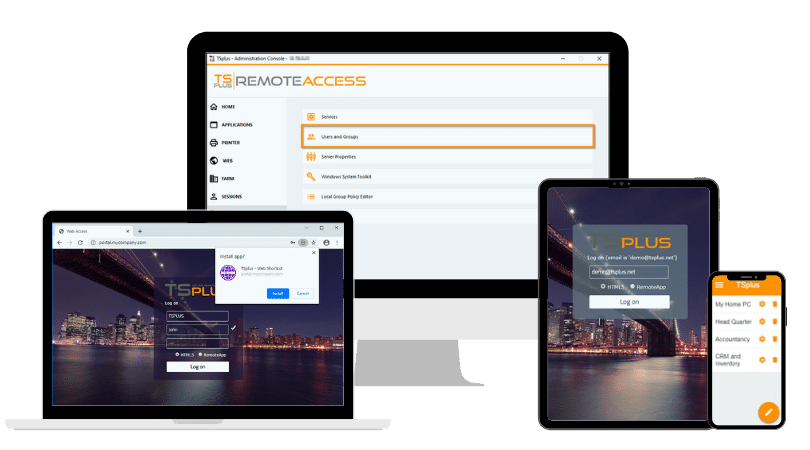)
)
Why Printer Redirection Matters
In a traditional office setting, your computer is connected directly to a local printer. But in a remote desktop setup, you are working on a different machine, often a server located elsewhere. Without printer redirection, you'd be unable to print directly from your remote session to your local printer.
This is where RDP's built-in printer redirection feature comes in. It allows users to access and print documents from a remote server as though they were working on their local machine. However, getting this to work correctly can require a bit of setup, especially in multi-user or complex environments.
Printer Redirection with TSplus: A Simplified Approach
TSplus enhances the remote desktop experience by offering a more streamlined and user-friendly solution to manage sessions, applications and printing across all types of environments. Printer Before diving into RDP settings or related TSplus Remote Access configuration, confirm that your local printer:
- is installed and working correctly;
- uses updated drivers on the local device;
- is connected either via USB, Wi-Fi or network.
Remember, TSplus leverages its Universal Printer and Virtual Printer, which work without requiring drivers to be installed on the server, thus minimizing compatibility issues.redirection is built into TSplus Universal Printer and TSplus Virtual Printer, making it easy to deploy across Windows networks, whether on-premises or cloud-based.
With TSplus, no need to struggle with driver installations on remote hosts or deal with inconsistent printing results. The platform ensures local printers appear in the remote session reliably and consistently without needing to be concerned with RDP questions. Still, let us address this printing in RDP matter nonetheless, and for the full details when using TSplus see the full description in our online documentation.
How Do I Get Printers to Work in RDP? Step-by-Step Guide
1. Check Your Local Printer Setup
Before diving into RDP settings or related TSplus Remote Access configuration, confirm that your local printer:
- is installed and working correctly;
- uses updated drivers on the local device;
- is connected either via USB, Wi-Fi or network.
Remember, TSplus leverages its Universal Printer and Virtual Printer, which work without requiring drivers to be installed on the server, thus minimizing compatibility issues.
2. Enable Printer Redirection in the Remote Desktop Client
If you are using the default Windows RDP client:
- Open Remote Desktop Connection (mstsc).
- Click Show Options.
- Navigate to the Local Resources tab.
- Under “Local devices and resources”, ensure Printers is checked.
- Optionally, click More... to select specific devices.
For TSplus Remote Access users, this process is even more seamless, as the system automatically manages redirection settings based on user profiles and admin configurations.
3. Confirm TSplus Server Settings
In the TSplus Admin Tool:
- Go to the Printer Management section.
- Ensure Universal Printer is enabled.
- Confirm that the printer mapping policy is set to allow redirection.
Thanks to NovaPDF, the TSplus Universal Printer ensures compatibility with nearly any local printer without requiring driver installation on the host, which is a major advantage in reducing support overhead.
4. Connect and Verify Printer Availability
After connecting to the remote session:
- Go to Devices and Printers in the Control Panel of the remote desktop.
- You should see your local printer listed, typically with a suffix like “(redirected X)” to indicate it’s tied to your current session.
You can now print via RDP, from the remote environment directly to your local device.
Advanced Tips for Multi-User Environments
If your environment supports multiple users logging into the same server (such as with TSplus Remote Access), printer redirection must be carefully managed to avoid conflicts and ensure privacy.
Tips:
- Use the TSplus Universal Printer for isolated, user-specific print sessions.
- Disable legacy printer redirection options if they interfere with the TSplus redirection system.
- Consider naming conventions for local printers to avoid software expecting a specific printer name.
With TSplus, each user session is isolated, ensuring one user’s printer setup does not interfere with another’s, even when using the same printer model.
Troubleshooting Common Printer Redirection Issues
Even with a solid setup, issues may occasionally arise. Here are a few common problems and how to fix them:
Printer Absent in Remote Session
- Make sure the Printers box is checked in the RDP client settings.
- Confirm the TSplus Universal Printer feature is active.
- Check if your printer is working locally.
Documents Print with Errors or Not at All
- Try updating or reinstalling the printer driver on the local machine.
- Ensure there are no network delays or connectivity issues.
Printer from One User Appears in Another Session
- This typically happens in misconfigured environments not using session isolation.
- TSplus properly manages redirection per session to prevent this. Double-check user group policies if this occurs.
Best Practice for Secure and Reliable Remote Printing
To maintain performance and security when using printer redirection:
- Use the Universal Printer: It simplifies redirection and minimizes configuration errors.
- Apply Group Policies selectively: Disable printer redirection only for users or groups where printing is not required.
- Monitor print queues: Avoid print jobs getting stuck by periodically checking server-side queues.
- Limit redirected devices: Only redirect essential peripherals like printers to reduce bandwidth use and security risk.
TSplus: The Smart Way to Enable Easy Remote Desktop Printing
The complexity of printer redirection in standard RDP set-ups often leads to frustration and inconsistent results. TSplus Universal Printer and Virtual Printer changes the game by simplifying configuration, offering driverless printing and ensuring that each session is cleanly managed: no conflicts, no guessing.
Whether you support remote workers, manage a call center or are deploying applications for mobile teams, TSplus delivers reliable, secure and easy remote desktop printing functionality out of the box.
TSplus Printing Solutions Comparison
As a help in selecting the most suitable printing method for specific needs, here is a table detailing the features of TSplus' three primary printing routes:Universal Printer, Virtual Printer and Standard RDP Printer Mapping.
| Feature | Universal Printer | Virtual Printer | Standard RDP Printer Mapping |
|---|---|---|---|
| Driver Installation on Server | Not required: utilizes novaPDF to generate PDFs on the server side. | Not required: employs a virtual driver on the client side. | Required: matching printer drivers must be installed on both client and server, which can be complex in multi-user environments. |
| Client-Side Requirements | ✅ Compatible with TSplus generated clients and HTML5 web clients. | ✅ Requires installation of the Virtual Printer client application on the user's local machine. | ✅ Compatible with standard RDP clients; no additional software needed. |
| HTML5 Client Support | ✅ Fully supported. | ❌ Not supported: requires native client installation. | ❌ Not supported: relies on native RDP client capabilities. |
| Printing Workflow🖨️ | Converts documents to PDF on the server, then transfers them to the client for local printing or preview. | Redirects print jobs directly to the local printer, maintaining original formatting and settings. | Sends print jobs from the server to the client's printer using RDP redirection; may encounter compatibility issues. |
| Multi-User Session Isolation | ✅ Ensures each user's print jobs are isolated within their session, preventing cross-user access. | ✅ Provides session-specific printer isolation, enhancing security and privacy. | ❌ Potential for printer conflicts and cross-user visibility if not properly configured. |
| Performance and Speed | Moderate: involves PDF conversion and transfer, which may introduce slight delays. | High: optimized for speed with minimal data transfer, suitable for high-volume printing. | Variable: dependent on network conditions and driver compatibility. |
| Best Use Cases | 🌐 Ideal for environments requiring web-based access and broad client compatibility without additional installations. | 🖥️ Suited for scenarios demanding high-performance printing with native client applications, such as in-office setups. | 🧩 Appropriate for simple, homogeneous environments where client and server configurations are standardized. |
| Compatibility with TSplus Clients | ✅ Compatible with TSplus generated clients and HTML5 clients. | ✅ Compatible with TSplus generated clients; not compatible with HTML5 clients. | ✅ Compatible with standard RDP clients; may require additional configuration. |
Choosing the Right Printing Solution
The above comparative table aims to help you inform your decisions tailored to your specific remote printing requirements. Here are our recommendations for use in concise terms:
- TSplus Universal Printer: Opt for this when you need a driverless, web-compatible solution which works seamlessly across various client devices without additional installations. This option is particularly effective in environments using HTML5 clients.
- TSplus Virtual Printer: Choose this for high-speed, native client scenarios where performance is paramount and installing a client application is feasible. It is ideal for office settings with consistent client configurations.
- TSplus Standard RDP Printer Mapping: Consider this in simple, homogeneous environments where client and server configurations are standardized and managing drivers across systems is feasible.
Conclusion: How do I get Printers to Work in RDP?
So, how do I get printers to work in RDP? The answer lies in combining proper client configuration with a robust remote desktop solution. TSplus Remote Access takes the guesswork out of the remote printing equation, offering intuitive tools, session isolation and universal printing which just works.
If you are tired of struggling with printer redirection in traditional RDP set-ups, try TSplus and experience the difference in ease, speed and reliability.
Start your free trial of TSplus software today to unlock hassle-free remote printing across your organization.

TSplus Remote Access Free Trial
Ultimate Citrix/RDS alternative for desktop/app access. Secure, cost-effective, on-premises/cloud














)
)
)